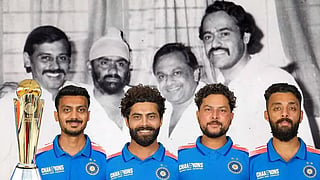
VK Sanju
There’s a scene from 83, the cinematic tribute to India’s maiden World Cup triumph, which perfectly captures the sheer terror of facing the West Indian quicks. When Roger Binny announces the menacing roll call of their pace attack, K Srikkanth quips: "Are we here to play cricket or to watch a horror movie?"
The West Indies' battery of fast bowlers in 1983 was nightmarish stuff - Andy Roberts, Michael Holding, Joel Garner and Malcolm Marshall - each capable of making even the bravest batter second-guess their career choices. This was a pace quartet designed to intimidate, destroy and conquer.
Long before the West Indian pace quartet terrorized batters and even before Cricket World Cup, India had its own fearsome four - a spin quartet that mesmerized the cricketing world with guile, not brute force.
The wizards of turn - Erapalli Prasanna, Srinivas Venkataraghavan, Bhagwat Chandrasekhar and Bishan Singh Bedi - wove magic with the ball, scripting victories against Australia, England, and New Zealand at a time when such feats seemed almost mythical for Indian cricket. Between them, they amassed 231 Test caps and 853 wickets. Despite their collective genius, fate allowed them to take the field together in just one Test - against England at Edgbaston in 1967.
In an era where cricketing laws are increasingly skewed in favour of the batters, India defied convention by spinning their way to ICC glory. Four specialist spinners took centre stage, silencing critics who scoffed at the selection committee’s gamble.
When the squad for the Champions Trophy was announced, cricketing purists raised their eyebrows - four spinners in a format often dictated by brute force! The skepticism only deepened when a fifth spinner was drafted in, replacing opener Yashasvi Jaiswal. The move rekindled memories of Mohinder Amarnath’s legendary quip about the selection committee - "A Bunch of Jokers!"
But the Indian think tank of chief selector Ajit Agarkar, head coach Gautam Gambhir and captain Rohit Sharma was far from clueless, knowing exactly what they were doing.
In the first two group matches, India fielded three spinners - Kuldeep Yadav, Ravindra Jadeja and Axar Patel - with the latter two offering all-round capabilities. Then, in a bold tactical move, Varun Chakravarthy replaced pacer Harshit Rana in the third match, elevating the spin count to four.
Varun seized the opportunity, weaving his magic to claim five wickets in a stunning performance. With his success, the team had no choice but to stick with the four-spinner strategy. Far from being a gamble, it became India’s winning formula. Each of the four spinners played a pivotal role, turning the tracks into a minefield for opponents and spinning India to Champions Trophy glory.
There was a compelling argument to bench Kuldeep Yadav for the final, given his relatively quiet performances in the group stage. But the team management stood by him and Kuldeep repaid that faith in style. With two early strikes, he ripped through New Zealand’s top order, dealing a blow from which they never truly recovered. This set the tone for India's dominance.
The Indian squad for the Champions Trophy was nothing short of an ensemble featuring every variety of spin bowling the game has to offer. Jadeja and Axar brought their precision as left-arm orthodox spinners, Kuldeep provided the mystery of left-arm wrist spin and Varun Chakravarthy represented the leg-spin contingent. The only specialist who didn’t get a game was off-spinner Washington Sundar.
In this spin brigade, Jadeja and Axar played the role of classic, old-school spinners and Varun and Kuldeep operated in the shadows, ensnaring batters with deception and mystery.
Much like the golden era of India's spin quartet, Mohammed Shami and Hardik Pandya were merely tasked with making the ball talk while it still had its shine. But from the sixth over of the final, the game belonged to the spinners.
Varun was never the first name on India's Champions Trophy squad list as he was seen as a T20 specialist who had never played Test cricket and a 'veteran' of just one first-class match. Despite playing only three matches in the Champions Trophy, he finished as India’s joint-highest wicket-taker alongside the seasoned Shami, both scalping nine wickets each. Kuldeep followed closely with seven, while Axar and Jadeja chipped in with five apiece. And that too when each of them conceding just around 4.5 runs per over.
Batters can win matches, but it’s the bowlers who win tournaments - Roger Binny in 1983, RP Singh in 2007, Zaheer Khan in 2011 and Arshdeep Singh in 2024. India has always been an inexhaustible mine of spin talent, yet never before had an ICC trophy been won with spinners dominating the wicket charts. That script was rewritten by the new spin quartet, led by Varun Chakravarthy.
